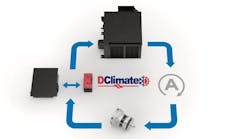One of the things that emerged from a study of the Federal Motor Carrier Safety Administration’s Compliance, Safety, Accountability (CSA) initiative is that lighting infractions are the leading reason a fleet’s maintenance CSA score can deteriorate. In 2011, lighting violations accounted for four of the top 11 violation categories, or about 25 percent of all violations. Yet, lighting violations are one of the easiest categories to prevent and control.
Meanwhile, we at Grote are finding out that many fleet maintenance programs are vastly underestimating the number of incandescent lamp replacements they are incurring, as well as the overall costs involved.
As an example, let’s take a 2,000-trailer fleet that uses 100 percent incandescent stop/tail/turn (S/T/T) lamps. The fleet has 8,000 S/T/T lamps in circulation.
At a 3.5-year average life expectancy per bulb, divided by 365 days per year, that fleet will experience approximately six S/T/T failures per day, which amazingly enough creates more than 2,000 downtime episodes per year due to these lighting issues alone. And before all those downtime episodes, there are more than 2,000 chances for an on-the-road lighting violation for that fleet.
It Gets Expensive
A non-functioning tail lamp is a 6-point CSA violation and that is added to both the fleet’s and the driver’s CSA score. Depending on the specific infraction, the episode can result in a parked truck waiting for hours for a $150 roadside service call. Or it may need to be taken in for maintenance, accompanied by repair labor costs.
Now add fuel and labor for the trips, perhaps a lost or late delivery with the associated unhappy customer and maybe, in certain circumstances, even a loss of a contract. All of this is, of course, a tremendous drag on a fleet’s productivity and profitability.
Easy to Spot
Lighting infractions are by far the easiest problems to spot. Once a rig is pulled over, a simple blown incandescent bulb can trigger a complete roadside inspection, resulting in having the truck off the road for a few hours and the assessment of more than six CSA lighting points.
Leading fleets are replacing their trailers’ bulb lamps with LED technology. However, some fleets still baulk at the initial cost of the more expensive LED lamps.
The return on investment in lamps that can stand up to continuous highway punishment is often lost on purchasing managers who are concerned in the short term with lowering purchased equipment costs. They keep their incandescents in place, putting off LED replacement until a new batch of trailers are ordered, or try to find the least expensive LED lamps they can, hoping to hold down initial lamp purchase costs as far as possible.
The key point to realize is that a LED conversion program should not be identified primarily as a cost. A lamp upgrade, when executed correctly, is an investment in fleet operational productivity and company-level profitability that will lower the number of on-the-road lighting failures and subsequent maintenance events caused by lighting.
The CSA dividend will come automatically, plus unplanned downtime caused by lighting systems can be reduced to a fraction of the previous program.
Fleets need to seriously address downtime, productivity and their CSA scores with a comprehensive lighting strategy and an investment in quality lighting equipment. The goal should be no unplanned downtime due to the entire lighting system.
The lower the cost of the initial investment, the lower the return on the bottom line.



